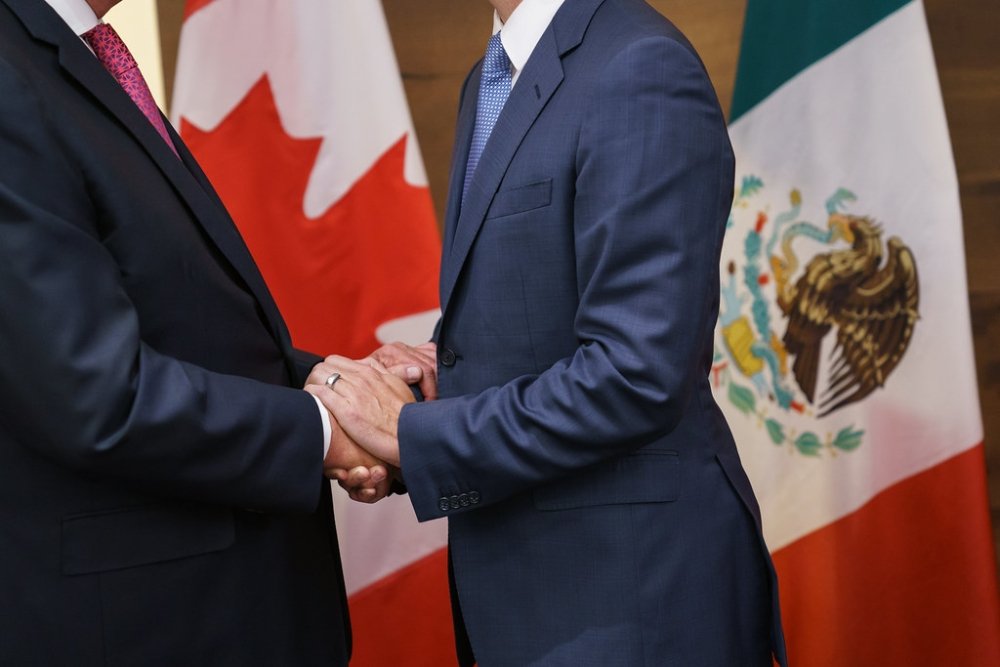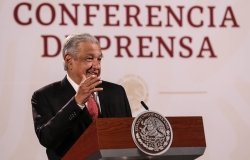Nearshoring, An Opportunity that is Mexico’s to Lose

Adam Scotti/Office of the Prime Minister
Mexico is privileged by geography. It is a country with a dual North American and Latin American identity that can serve as a bridge between the two regions. Mexico stands to gain from the current global geopolitical context that involves economic competition between the US and China, armed conflict in the Middle East and in Ukraine, and a desire for many companies to be close to the largest and most dynamic economy in the world, the United States.
What Mexico does not have is a clearly articulated strategy to take advantage of the nearshoring opportunity, which, by definition, will not last forever. Given its geographical location and its vertical integration with the US and Canadian economies, enshrined under the USMCA, Mexico is by far the most obvious place to relocate manufacturing or service operations from China, but it is not the only option either. Various states in the US, and other countries in Latin America and the Caribbean, and South East Asia will also be making their pitches to investors.
Given the commercial and security tensions that exist with China, some authorities in the US realize that they need to up their game to consolidate relationships with other Western Hemisphere countries, which is why a group of both Republican and Democratic senators have put together the Americas Act.
This legislation, which was introduced in early March, would establish programs to promote greater trade, investment, and people-to-people ties throughout Latin America and the Caribbean, potentially expanding the USMCA. “At its core, the Americas Act is a multi-billion-dollar job creation tool for the U.S. and its allies in Latin America and the Caribbean,” said Representative Adriano Espaillat (D-NY). “With its reshoring and nearshoring loans, tax benefits, and other targeted grant assistance for workers at home and in our Western Hemisphere partner countries, the Americas Act will bring jobs and investment back to our Hemisphere and stem the root causes of migration by putting more money into the pockets of working families.”
While the idea of expanding the USMCA beyond North America might be an attractive idea for boosting regional competitiveness from a US perspective, it would erode the privileged trade advantages that Mexico currently enjoys in its relationship with the US and Canada, something the next presidential administration in Mexico should consider as plans are developed to push forward to proactively attract nearshoring foreign direct investment (FDI).
As it stands, Mexico’s FDI numbers sound encouraging. But of the $36 billion dollars registered in 2023, only $5bn were new investments [1], which means nearshoring may be happening, but the tide is bringing in soft waves, not the desired tsunami.
Creating the optimal ecosystem
President Andrés Manuel López Obrador issued an executive order on October 11th, 2023 that provides for fiscal incentives for particular industries, including the agricultural sector, auto parts manufacturing, pharmaceuticals, and the film industry, among others, as well as incentives for worker training. [2]
This decision gained little attention, and while it is better than nothing, it is too little too late. Given Mexico’s geographical comparative advantages, fiscal incentives are not the core of what companies want when they analyze whether to locate their operations in the country. Rather, investors need a business and public policy ecosystem that allows them to optimize opportunities and minimize risks over long periods of time, something that Mexico’s next government can do a lot to improve.
Creating a winning nearshoring strategy for Mexico implies a complex series of considerations and a reinvigorated investment promotion strategy globally, something that fell apart with the elimination of ProMexico —a federal agency that had been charged with promoting foreign trade and investment— at the beginning of the AMLO administration. While the former ProMéxico’s operations surely could have been optimized, eliminating the organization completely and leaving promotion to the already overly taxed embassies was a mistake. As a result, Mexico has lost precious time and valuable relationships, and the country now needs to interrupt its leisurely walk and start sprinting.
Below are reflections on the core issues that should be addressed to create optimal conditions for attracting and retaining foreign investment.
Embrace the energy transition
In order to be able to receive significant new amounts of investment, Mexico will need to produce both larger quantities of energy and ensure that it comes from cleaner sources. Global companies that consider Mexico as a place to invest long term need access to low-emission hydrocarbons, as well as renewable energy, and Mexico is lacking in both.
Given Mexico’s complex history that views oil as a fundamental part of the country’s sovereignty, embracing the energy transition from a political perspective has posed challenges. AMLO did all he could to roll back the opening up of the energy sector to private sector participation that began in 2014, and invested hundreds of millions of dollars in public funds to prop up the ailing national oil monopoly, Pemex. He also strengthened the monopoly of the national electricity company, CFE, making it harder for companies to generate their own electricity resources or explore renewable options.
Suffice it to say that instead of developing Mexico’s comparative advantages in wind, solar, and geothermal renewable energy, in recent years Mexico has invested in the energy resources of the 20th Century, not the 21st. While highly frustrating from both a pragmatic energy production and climate change abatement perspective, it is not too late to make adjustments that can boost supply and offer lower emission hydrocarbons and renewable energy to the Mexican population.
A good place to start to increase energy efficiency and security, would be to capture the methane emissions (natural gas) stemming from Pemex’s oil production facilities. Based on their own scientific studies, the Environmental Defence Fund estimates that by capturing the emissions from Nuevo Pemex alone, Mexico could fill 50% of the country’s residential demand for natural gas. At the moment, instead of capturing these emissions, Pemex burns the methane; the state-owned company’s laser-focused aim is to produce oil. Foolhardy.
Consistency in regulation and the rules of the game
I use the turn of phrase “consistency in regulation and the rules of the game” so as to avoid the also much-needed but more theoretical term, “rule of law.” Businesses need to know that when they make a decision that will affect the long-term sustainability and profitability of their organizations, they are making a co-investment with the country where they have decided to do so. In fact, this is perfectly in line with the idea of attracting investment that will add to the well-being (bienestar) of the Mexican communities where these investments will be made. The investment needs to be good for both sides with a long-term view of success.
As a result of the setbacks in the opening up of the energy sector and the suboptimal situations in which companies like Constellation Brands found themselves in recent years, yellow flags have been raised, making some in the private sector weary. Companies will be waiting to see how the next government views its own role in establishing a trustworthy business environment.
Science and innovation
Globally we need to embrace science as a fact-based tool for providing the solutions that will allow our species to continue surviving on this planet. And Mexico is no exception.
Taking a science-based approach is critical for issues like climate change, which is intimately tied to the energy sector mentioned above, and is also linked to urban planning, infrastructure investment, and human health. It is through science and innovation that we will find the solutions that can provide well-being for the communities that make up our nations and regions.
In Mexico, the regulatory framework approach to issues like Artificial Intelligence (AI) and cybersecurity, tends to be short-sighted and focused on providing the government with the tools of control, which in this day and age is an exercise in futility. New trends in technology do need to be regulated to prevent threats to national security and critical infrastructure, ensure respect for human rights and to maintain market conditions that are competitive. Doing so requires ensuring the active involvement of the private sector, which understands these tools and their implications best.
If the goal is to encourage more investors to see Mexico as a viable nearshoring hub, a policy of support for science and innovation is critical.
Increase public investment
In general the Mexican state needs to invest more in public goods and services across the board in areas like health, education and infrastructure. Mexico is the OECD country that invests the least, with a rate of public sector investment of 1.3% in 2020, 0.7% below the 2007 rate.
Public sector investments lag because Mexico’s public revenue generation is the least effective in the OECD and one of the lowest in the region. Mexico's tax-to-GDP ratio in 2021 stood at 16.7%, below the Latin America and Caribbean average of 22% and far below the OECD average of 34%. [3] A serious look at public finances is required to make the investments needed to decrease poverty and increase equality.
Spurring investment in public goods and services will be a challenge for the next federal government given that Mexico faces a sizable budgetary deficit, which is forecasted to reach 5.9% of GDP in 2024 —a historic high according to the most recent official figures and an increase of 1.6% percentage points relative to 2023. [4]
Human capital
While the same could be said for many countries - the US included - Mexico's public education system is deficient, a fact that creates great social inequities as well as challenges for companies looking for talent.
The most recent results of the Programme for International Student Assessment (PISA) showed that the knowledge and skills of 15-year-old students in mathematics, reading and science has declined, with Mexico ranked 51st out of 81 countries analyzed.[5]
Analysts tend to focus on the number of engineers in Mexico given its manufacturing base, and while their talents are certainly needed, there are other soft skills —effective communication, as well as analytical and creative thinking— that need to be emphasized more in Mexico’s educational system if we intend to successfully integrate our economy into global supply chains and take advantage of emerging technologies. It must be okay to think innovatively and question the status quo, something that is still a rarity in the work culture of Mexico.
Further, Mexico needs to consider female gender empowerment a cornerstone of its economic policy; a country cannot excel by leaving 51% of the population to languish in the informal sector. Mexico has one of the lowest workforce participation rates in Latin America (below Brazil, Chile, Colombia, Costa Rica) because women shoulder the burden of care from birth to death.[6] This has to change.
On a positive note, the feminist movement is stronger and better organized than ever in Mexico and is advocating for government programs that will provide assistance with the burdens related to family care. Oxfam has done particularly valuable work in this regard.[7]
Invest in Infrastructure via PPPs
According to some estimates, Mexico needs to invest around 5% of GDP[8] a year in infrastructure to meet the needs required for optimal competitiveness, a very tall order given that Mexico currently invests only 1.5% of GDP.
Given limited public resources, embracing Public Private Partnerships (PPPs) provides an excellent option. PPPs help enable financing under long-term risk-sharing arrangements and are something that Mexico should utilize in order to attract nearshoring dollars that can establish valuable infrastructure assets for years to come.
Foreign policy as a domestic policy tool
The administration of AMLO has been fond of saying that the best foreign policy is a domestic one, without explaining very clearly how that might work. What is clear, however, is that a wise foreign policy can significantly add to domestic policy goals, such as job creation.
Mexico’s incoming administration would do well to use Mexico's size and relevance to at the very least punch at its weight, something it has stopped doing globally over the last five years. Mexico needs to develop a strategy with respect to China and not just let things happen without intention. And that is not to say that Mexico has to adopt the same policies of the US, on the contrary. It may be in the best interests of Mexico to adopt a conscious strategy of “non-alignment,” but at the moment we have a non-strategy, which makes us vulnerable to the long-term strategies of other countries that, without a doubt, are doing their own planning.
Teamwork is good
Attracting nearshoring dollars should be viewed as a team effort in Mexico, with the public and private sectors communicating and strategizing together. The goal is to work as a team to encourage investment that will bring jobs, economic growth, new technologies and improved well-being.
Like many societies globally, Mexico has been divided against itself in recent years. A team that has no clear plan and that mistrusts its own players, rarely wins. Loving one’s country is about caring about the people who live in it. When that kind of solidarity is emphasized, it shows and leads to victories.
The North American Powerhouse
Mexico, Canada and the US already have economies that are vertically integrated in many sectors, from the automotive industry to the agricultural sector. Given the complexities of current geopolitics, renewing the commitment to work together as a region behooves all three countries. The USMCA will be reviewed in 2026 and instead of seeing this as a moment to challenge the agreement’s value, it should be viewed as an opportunity to strengthen the agreement for mutual benefit.
The US economy has proved incredibly resilient in the wake of both the pandemic and global economic turbulence, something that is a big advantage for its neighbors to the north and the south. Further, the US has achieved energy independence over the last decade, and together with Canada and Mexico North America can build the next generation of energy solutions based on a transition toward multiple renewable energy solutions. This will indeed make North America the ideal place for investment for decades to come and a true global energy powerhouse.
Opportunities do not last forever
Mexico would do well to understand that opportunities do not last forever. As a nation, we need to hit the ground running in 2025, work together, and create a prosperous future that is in the interests of all citizens within and without the national borders. Between 30 and 40 million Mexicans live beyond the nation’s borders and nearshoring opportunities will also provide them with the possibility of joining a team focused on achieving sustainable prosperity.
Regional footnote:
An exciting time to celebrate North America will take place the same year as the review of the USMCA, the World Cup 2026. The opening game will take place in the Azteca Stadium, a perfect moment to display the size, importance, and cultural significance of the Mexican nation, together with our North American counterparts. My hope is that via this celebratory event, more North Americans of the US, Canada, and Mexico will embrace a regional identity, making future cooperation more ambitious and politically viable.
[1] Instituto Mexicano para la Competitividad (www.imco.org.mx ).
[2] Diario de la Federación, 11 de octubre de 2023: DECRETO por el que se otorgan estímulos fiscales a sectores clave de la industria exportadora consistentes en la deducción inmediata de la inversión en bienes nuevos de activo fijo y la deducción adicional de gastos de capacitación.
[3] https://www.oecd.org/tax/revenue-statistics-mexico.pdf
[4] Pre-criterios Generales de Política Económica 2025”, Secretaría de Hacienda y Crédito Público, https://www.finanzaspublicas.hacienda.gob.mx/work/models/Finanzas_Publicas/docs/paquete_economico/precgpe/precgpe_2025.PDF
[5] https://www.oecd.org/publication/pisa-2022-results/country-notes/mexico-519eaf88/
[6] The women’s labor force participation rate in Mexico continues to be one of the most lagging in Latin America, at around 49%, well below the OECD average of 65% and 58% for the region.
[7] https://oxfammexico.org/trabajo-de-cuidados-y-desigualdad/
[8]https://www.cnec.org.mx/blogs/post/declaración-de-méxico-sobre-la-importancia-de-la-infraestructura-y-su-planeación-a-largo-plazo-para
About the Author


Mexico Institute
The Mexico Institute seeks to improve understanding, communication, and cooperation between Mexico and the United States by promoting original research, encouraging public discussion, and proposing policy options for enhancing the bilateral relationship. A binational Advisory Board, chaired by Luis Téllez and Earl Anthony Wayne, oversees the work of the Mexico Institute. Read more










